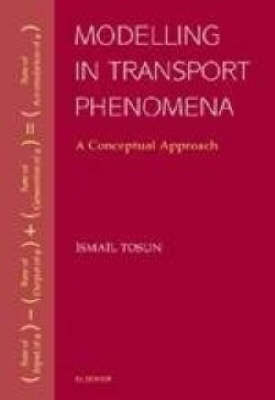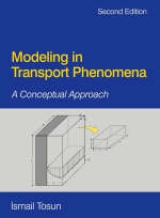
Modelling in Transport Phenomena
Elsevier Science Ltd (Verlag)
978-0-444-51052-5 (ISBN)
- Titel erscheint in neuer Auflage
- Artikel merken
Modelling in Transport Phenomena: A Conceptual Approach aims to show students how to translate the inventory rate equation into mathematical terms at both the macroscopic and microscopic levels. The emphasis is on obtaining the equation representing a physical phenomenon and its interpretation. The book begins with a discussion of basic concepts and their characteristics. It then explains the terms appearing in the inventory rate equation, including ""rate of input"" and ""rate of output."" The rate of generation in transport of mass, momentum, and energy is also described. Subsequent chapters detail the application of inventory rate equations at the macroscopic and microscopic levels. This book is intended as an undergraduate textbook for an introductory Transport Phenomena course in the junior year. It can also be used in unit operations courses in conjunction with standard textbooks. Although it is written for students majoring in chemical engineering, it can also serve as a reference or supplementary text in environmental, mechanical, petroleum, and civil engineering courses.
The author has been teaching undergraduate and graduate level thermodynamics courses for over 40 years. Since 1980 he has been a faculty member at the Middle East Technical University (METU), Ankara, Turkey. He has also taught at the Turkish Military Academy and the University of Akron, Ohio. Professor Tosun received his BS and MS degrees from METU, and a PhD degree from the University of Akron, all in chemical engineering. His research interests include mathematical modeling and transport phenomena. Professor Tosun is the author of the following books: • Modeling in Transport Phenomena – A Conceptual Approach, 2nd ed., Elsevier, 2007. • Fundamental Mass Transfer Concepts in Engineering Applications, CRC Press, 2019. • Thermodynamics – Principles and Applications, 2nd ed., World Scientific, 2020.
Preface 1 Introduction 1.1 Basic Concepts 1.1.1 Characteristics of the Basic Concepts 1.2 Definitions 1.2.1 Steady-State 1.2.2 Uniform 1.2.3 Equilibrium 1.2.4 Flux 1.3 Mathematical Formulation of the Basic Concepts 1.3.1 Inlet and Outlet Terms 1.3.2 Rate of Generation Term 1.3.3 Rate of Accumulation Term 1.4 Simplification of the Rate Equation 1.4.1 Steady-State Transport without Generation 1.4.2 Steady-State Transport with Generation 2 Molecular and Convective Transport 2.1 Molecular Transport 2.1.1 Newton's Law of Viscosity 2.1.2 Fourier's Law of Heat Conduction 2.1.3 Fick's First Law of Diffusion 2.2 Dimensionless Numbers 2.3 Convective Transport 2.4 Total Flux 2.4.1 Rate of Mass Entering and/or Leaving the System 2.4.2 Rate of Energy Entering and/or Leaving the System 3 Interphase Transport and Transfer Coefficients 3.1 Friction Factor 3.1.1 Physical Interpretation of Friction Factor 3.2 Heat Transfer Coefficient 3.2.1 Convection Heat Transfer Coefficient 3.2.2 Radiation Heat Transfer Coefficient 3.3 Mass Transfer Coefficient 3.3.1 Physical Interpretation of Mass Transfer Coefficient 3.3.2 Concentration at the Phase interface 3.4 Dimensionless Numbers 3.5 Transport Analogies 3.5.1 The Reynolds Analogy 3.5.2 The Chilton-Colburn Analogy 4 Evaluation of Transfer Coefficients: Engineering Correlations 4.1 Reference Temperature and Concentration 4.1.1 Bulk Temperature and Concentration 4.1.2 Film Temperature and Concentration 4.2 Flow Past a Flat Plate 4.3 Flow Past a Single Sphere 4.3.1 Friction Factor Correlations 4.3.2 Heat Transfer Correlations 4.3.3 Mass Transfer Correlations 4.4 Flow Normal to a Single Cylinder 4.4.1 Friction Factor Correlations 4.4.2 Heat Transfer Correlations 4.4.3 Mass Transfer Correlations 4.5 Flow in Circular Pipes 4.5.1 Friction Factor Correlations 4.5.2 Heat Transfer Correlations 4.5.3 Mass Transfer Correlations 4.5.4 Flow in Non-Circular Ducts 4.6 Flow in Packed Beds 4.6.1 Friction Factor Correlations 4.6.2 Heat Transfer Correlation 4.6.3 Mass Transfer Correlation 5 Rate of Generation in Momentum, Energy and Mass Transfer 5.1 Rate of Generation in Momentum Transport 5.1.1 Momentum Generation as a Result of Gravitational Force 5.1.2 Momentum Generation as a Result of Pressure Force 5.1.3 Modified Pressure 5.2 Rate of Generation in Energy Transport 5.3 Rate of Generation in Mass Transport 5.3.1 Stoichiometry of a Chemical Reaction 5.3.2 The Law of Combining Proportions 5.3.3 Rate of Reaction 6 Steady-State Macroscopic Balances 6.1 Conservation of Chemical Species 6.2 Conservation of Mass 6.3 Conservation of Energy 6.3.1 Energy Equation without Chemical Reaction 6.3.2 Energy Equation with Chemical Reaction 7 Unsteady-State Macroscopic Balances 7.1 Approximations Used in Unsteady Processes 7.1.1 Pseudo-Steady-State Approximation 7.1.2 No Variation of Dependent Variable within the Phase of Interest 7.2 Conservation of Chemical Species 7.3 Conservation of Total Mass 7.4 Conservation of Momentum 7.5 Conservation of Energy 7.5.1 Unsteady-State Energy Balance around a Continuous Stirred Tank Reactor 7.6 Design of a Spray Tower 7.6.1 Determination of Tower Diameter 7.6.2 Determination of Tower Height 8 Steady-State Microscopic Balances without Generation 8.1 Momentum Transport 8.1.1 Plane Couette Flow 8.1.2 Annular Couette Flow 8.2 Energy Transport without Convection 8.2.1 Conduction in Rectangular Coordinates 8.2.2 Conduction in Cylindrical Coordinates 8.2.3 Conduction in Spherical Coordinates 8.2.4 Conduction in a Fin 8.3 Energy Transport with Convection 8.4 Mass Transport without Convection 8.5 Mass Transport with Convection 8.4.1 Diffusion in Rectangular Coordinates 8.4.2 Diffusion in Cylindrical Coordinates 8.4.3 Diffusion in Spherical Coordinates 8.4.4 Diffusion and Reaction in a Catalyst Pore 8.5 Mass Transport with Convection 8.5.1 Diffusion through a Stagnant Gas 8.5.2 Diffusion through a Stagnant Liquid 8.5.3 Diffusion with Heterogeneous Chemical Reaction9 Steady-State Microscopic Balances with Generation 9.1 Momentum Transport 9.1.1 Flow between Parallel Plates 9.1.2 Falling Film on a Vertical Plate 9.1.3 Flow in a Circular Tube 9.1.4 Axial Flow in an Annulus 9.1.5 Physical Significance of the Reynolds Number 9.2 Energy Transport without Convection 9.2.1 Conduction in Rectangular Coordinates 9.2.2 Conduction in Cylindrical Coordinates 9.2.3 Conduction in Spherical Coordinates 9.3 Heat Transfer with Convection 9.3.1 Laminar Flow Forced Convection in a Pipe 9.3.2 Viscous Heating in a Couette Flow 9.4 Mass Transfer without Convection 9.4.1 Diffusion in a Liquid with Homogeneous Reaction 9.4.2 Diffusion in a Spherical Particle with Homogeneous Reaction 9.5 Mass Transfer with Convection 9.5.1 Laminar Forced Convection in a Pipe 9.5.2 Diffusion Into a Falling Liquid Film 9.5.3 Analysis of a Plug Flow Reactor 10 Unsteady-State Microscopic Balances without Generation 10.1 Momentum Transport 10.1.1 Solution for Short Times 10.2 Energy Transport 10.2.1 Heating of a Rectangular Slab 10.2.2 Heating of a Rectangular Slab: Revisited 10.2.3 Heating of a Spherical Particle 10.3 Mass Transport 10.3.1 Mass Transfer Into a Rectangular Slab 10.3.2 Gas Absorption Into a Spherical Droplet 11 Unsteady-State Microscopic Balances with Generation 11.1 Unsteady Laminar Flow in a Tube 11.1.1 Exact Solution 11.1.2 Approximate Solution by the Area Averaging Technique 11.2 Unsteady Conduction with Heat Generation 11.3 Absorption with Reaction A Mathematical Preliminaries A.1 The Cylindrical and Spherical Coordinate Systems A.2 Mean Value Theorem A.3 Slopes on Log-Log and Semi-Log Graph Papers A.4 Leibnitz's Rule for Differentiation of Integrals A.5 Numerical Differentiation A.5.1 Douglass-Avakian Method A.5.2 Whitaker-Pigford Method A.6 Regression and Correlation A.6.1 Simple Linear Regression A.6.2 Sum of Squared Deviations A.6.3 The Method of Least Squares A.6.4 Correlation Coefficient A.7 The Root of an Equation A.7.1 Roots of a Polynomial A.7.2 Numerical Methods A.8 Methods of Integration A.8.1 Mean Value Theorem A.8.2 Graphical Integration A.8.3 Numerical Integration or Quadrature A.8.4 Numerical Integration When the Integrand is a Continuous Function A.9 Matrices A.9.1 Fundamental Algebraic Operations A.9.2 Determinants A.9.3 Types of Matrices A.9.4 Solution of Simultaneous Algebraic Equations B Solutions of Differential Equations B.1 First-Order Equations with Exact Solutions B.1.1 Separable Equations B.1.2 Exact Equations B.1.3 Homogeneous Equations B.1.4 Linear Equations B.1.5 Bernoulli Equations B.2 Second-Order Linear Differential Equations B.2.1 Special Case of a Second-Order Equation B.2.2 Solution of a Non-Homogenous Differential Equation B.2.3 Bessel's Equation B.2.4 Numerical Solution of Initial Value Problems B.2.5 Solution of Simultaneous Differential Equations B.3 Second-Order Partial Differential Equations B.3.1 Classification of Partial Differential Equations B.3.2 Orthogonal Functions B.3.3 Self-Adjoint Problems B.3.4 The Sturm-Liouville Problem B.3.5 Fourier Series B.3.6 Solution of Partial Differential Equations C Flux Expressions D Physical Properties E Constants and Conversion Factors Index
| Erscheint lt. Verlag | 15.8.2002 |
|---|---|
| Verlagsort | Oxford |
| Sprache | englisch |
| Maße | 152 x 229 mm |
| Gewicht | 1250 g |
| Themenwelt | Technik ► Bauwesen |
| Technik ► Elektrotechnik / Energietechnik | |
| Technik ► Maschinenbau | |
| ISBN-10 | 0-444-51052-4 / 0444510524 |
| ISBN-13 | 978-0-444-51052-5 / 9780444510525 |
| Zustand | Neuware |
| Haben Sie eine Frage zum Produkt? |
aus dem Bereich



